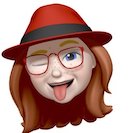Donna Benjamin
December 2007
Infonet 2007 Volume 17 Number 4
Earlier this year, I engaged in some  professional learning by taking a Red Hat Master Class with Andy Fitzsimon on "Open Source Graphic Design".
professional learning by taking a Red Hat Master Class with Andy Fitzsimon on "Open Source Graphic Design".
Andy spoke primarily about three Open Source tools, the GIMP (Image manipulation), Scribus (Desktop Publishing) and went on to cover Inkscape (Vector Illustration) in particular detail. Each of these tools are freely available for download from the Internet, with no restriction on the number of computers they can be installed on, including students' and teachers' home machines. Another benefit is that all three programs are available for Windows, MacOS and Linux.
One of the core intentions of the Inkscape team is to develop a complete implementation of the Scalable Vector Graphic (SVG) open standard. SVG is used for the creation of two-dimensional graphics using an XML based file format. Key features include shapes, text and the ability to embed other image formats.
SVG is being used in many areas including Web graphics, animation, user interfaces, graphics interchange, print and hardcopy output, mobile applications and high-quality design.
As a royalty-free vendor-neutral open standard, SVG is developed under the W3C Process, has strong industry support and is interoperable.
http://inkscape.org/
http://svg.org/
http://www.adobe.com/svg/
http://www.w3.org/Graphics/SVG/
So, let's take a look at Inkscape.
A quick glance at the user interface shows a range of tools in easy reach. Shapes - Squares, Circles, Polygons or Stars and Spirals. There's single click access to flip and align shapes or objects. It seems pretty easy to get started creating vector graphics in Inkscape. The application is easy to use for beginners, but contains many of the powerful features demanded by Graphic Designers.
The program contains tutorials in SVG format available from the Help menu. Because the tutorials are in the same format inkscape uses natively it is possible to experiment with the objects in the tutorials themselves.
A comprehensive listing of keyboard shortcuts is also available from the Help menu so power users can quickly develop efficiencies when conducting repetitive transformations. The header graphic for this article was created in Inkscape - using a few of the most basic tools. The round chequered shape was made using the star tool. It has 16 corners, a spoke ratio of 0.083 with the points rounded to 0.757 degrees. That might sound a bit mathematical, and it is, but node handles mean this can be edited and manipulated intuitively with a mouse or graphics tablet.
The header graphic for this article was created in Inkscape - using a few of the most basic tools. The round chequered shape was made using the star tool. It has 16 corners, a spoke ratio of 0.083 with the points rounded to 0.757 degrees. That might sound a bit mathematical, and it is, but node handles mean this can be edited and manipulated intuitively with a mouse or graphics tablet.
Inkscape is lots of fun, I have used the Windows and Linux versions, and shared files back and forth. Designers working with Corel Draw and Adobe Illustrator have also been able to simply import my files saved as 'plain' SVG. So I can vouch for it being cross-platform and interoperable. As an open source project it's possible to contact the developers online, and Andy Fitzsimon, told us he gets a copy of the development version daily and works directly with the developers to fix bugs and fine-tune new features. He uses inkscape in his daily work developing graphics for Red Hat. He uses it to produce graphics in multiple languages very simply, because he can develop the graphics independantly of the language - the words can be edited in XML using unicode characters.
It's worth sinking some time into exploring the functionality of Inkscape - it's more than worth the price.
